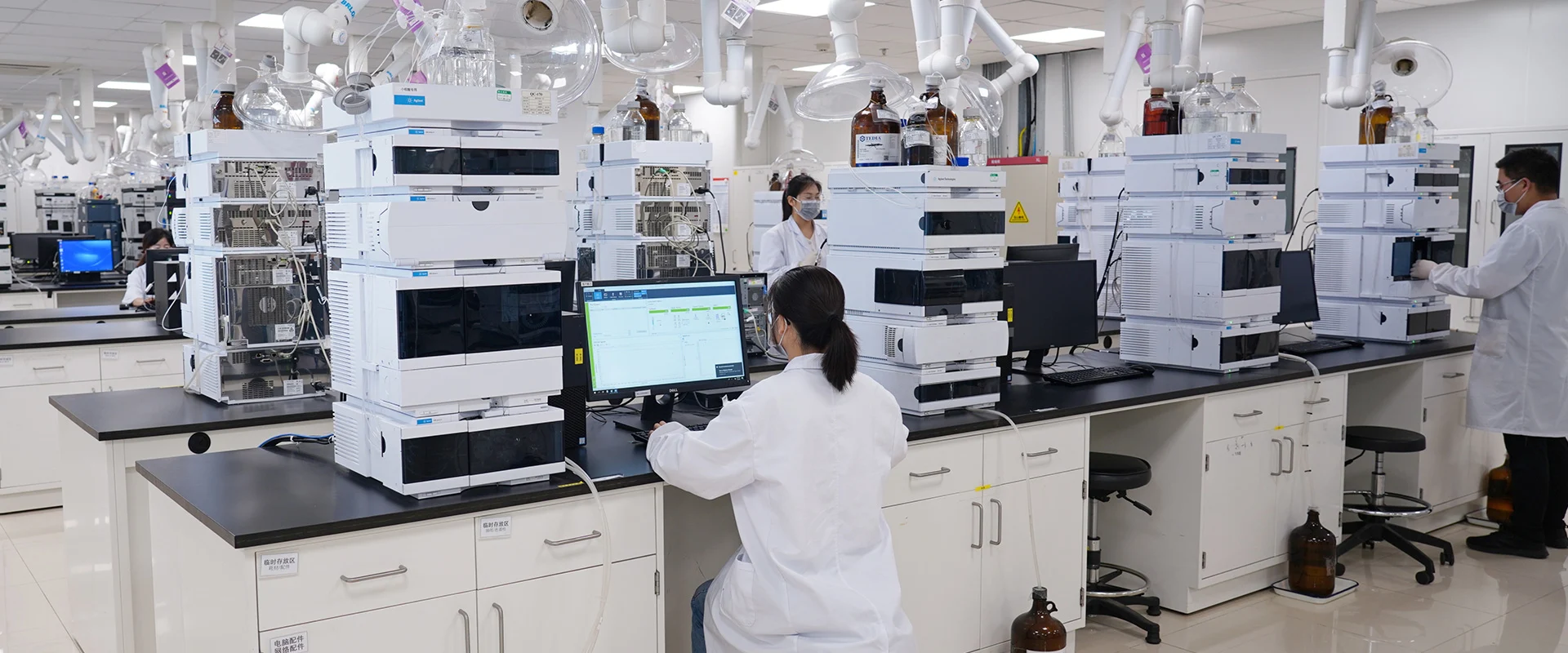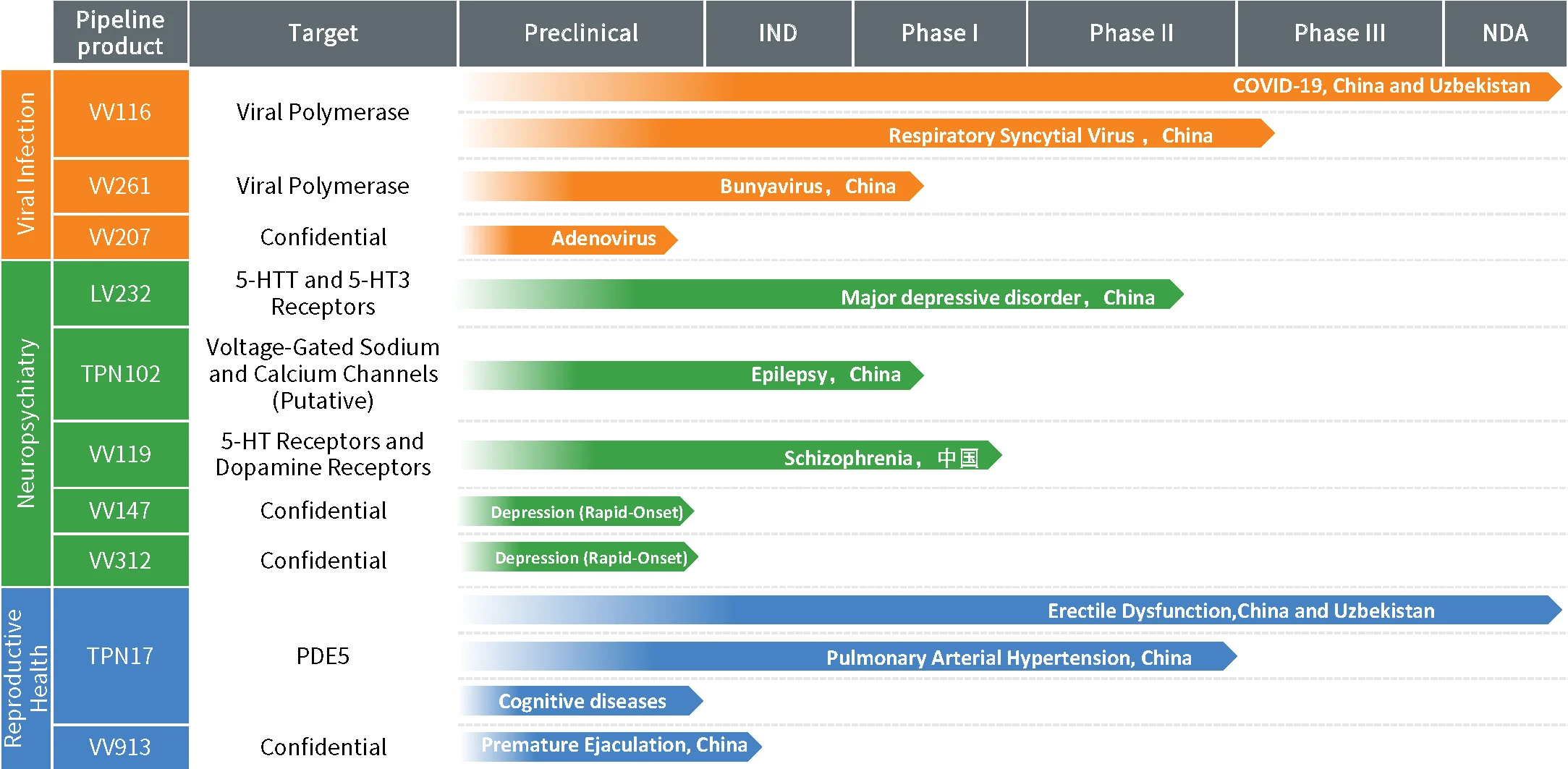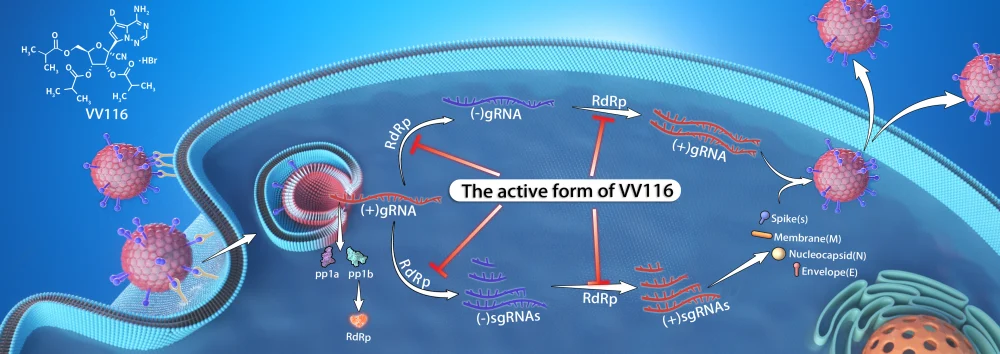

VV116 is a novel oral nucleoside prodrug. In January 2023, it was conditionally approved by the National Medical Products Administration for marketing under the trade name 民得维®, and was converted from conditional to regular approval in January 2025, for the treatment of mild to moderate COVID-19 adult patients. Subsequently, in December 2023, it was first under negotiation for China’s national medical insurance and officially added to the 2023 national medical insurance catalogue. Prior to this, in December 2021, VV116 was approved for marketing in Uzbekistan under the trade name Mindvy®, for the treatment of mild, moderate, and severe COVID-19 in adult patients.
Preclinical studies show that VV116 has strong antiviral efficacy, with equivalent activity levels (EC50 = 0.1~0.3 µM) against the original strain of the SARS-CoV-2 and known major variant strains. In a mouse model, oral administration (50 mpk) for 5 days reduced the viral titer in the lungs of mice to below the detection line. VV116 has no genetic toxicity, a lower risk of drug interactions, and potentially a wider applicable population. A clinical trial published in The Lancet Infectious Diseases showed that oral administration of VV116 can significantly shorten the clinical recovery time of patients, reduce viral load, and the incidence of adverse events is comparable to placebo. Another clinical trial published in The New England Journal of Medicine showed that the efficacy of VV116 is not inferior to Paxlovid®, and the incidence of adverse events is even lower.
VV116 has a broad-spectrum anti-RNA virus effect. VV116 also has good in vitro inhibitory activity against other RNA viruses, including other human coronaviruses (such as OC43), respiratory syncytial virus (RSV), dengue fever virus, Zika virus, Ebola virus, etc. Among them, VV116 has a significant anti-RSV effect. In a mouse model, oral administration (50 mpk) for 4 days reduced the RSV titer in the lungs of mice to below the detection line.
The Phase I clinical trial of VV116 dry mixed suspension for the treatment of respiratory syncytial virus infection has been completed, and the Phase II clinical trial is currently in progress. The results of the Phase I clinical study showed that a single oral dose of 25, 100, 300 mg of VV116 dry mixed suspension, the main pharmacokinetic parameters of the main metabolite 116-N1 (parent nucleoside) increased proportionally with the dose, conforming to linear pharmacokinetic characteristics; the bioavailability of 116-N1 was not significantly affected when taken with infant formula milk at the same time; the safety was good.

VV116 is rapidly absorbed orally and, after first-pass metabolism, quickly transforms into the parent nucleoside and enters the systemic circulation, from where it is transported to virus-susceptible organs such as the lungs, heart, intestines, and kidneys. Once the VV116 parent nucleoside enters the cell, it is converted into the active form of nucleoside triphosphate after three steps of phosphorylation. This active form is incorporated into the RNA chain of the novel coronavirus under the catalysis of RNA-dependent RNA polymerase (RdRp), inhibiting viral replication by terminating RNA synthesis. RdRp is the core component of the transcription and replication of the novel coronavirus, and its active center is highly conserved. Therefore, it is speculated that VV116 is not easily affected by viral mutations and is expected to be able to cope with new mutant strains that may appear in the future.
TPN171 is a novel highly selective phosphodiesterase type 5 (PDE5) inhibitor. In September 2022, it was approved for marketing in Uzbekistan under the trade name ONVITA®, for the treatment of erectile dysfunction (ED). The Phase III clinical trial of TPN171 for the treatment of ED has been completed domestically. Vigonvita has submitted a New Drug Application (NDA) for this indication in China and the NDA has been accepted.
TPN171 has significant clinical efficacy, and the effective dose is lower than that of drugs with the same target, with a clinically recommended dose of 5 mg. In a randomized, double-blind, placebo-controlled, multi-center phase III clinical trial, 765 ED patients took 2.5 mg, 5 mg, 10 mg of TPN171 or placebo for 12 weeks. The results showed that all dosage groups of TPN171 significantly outperformed the placebo group in terms of improvement in erectile function, success rate of penile insertion and maintaining erection.
TPN171 has a high safety profile. No common adverse reactions such as myalgia and abnormal vision occurred in the Phase III clinical study, which are common in drugs with the same target. The results of a two-period crossover, placebo-controlled Phase I clinical study of TPN171 showed that after a single oral dose of 10 mg TPN171 under fasting condition, there was no effect on sperm motility, sperm vitality, total sperm count, density, morphology, semen volume, and semen viscosity. The results of a randomized, double-blind, placebo-controlled C-QT/QTc Phase I clinical study showed that there is no risk of QTc interval prolongation within the range of 10 mg to 50 mg after a single oral dose of TPN171 under fasting condition.
TPN171 has good medication adherence. The pharmacokinetic characteristics and safety of TPN171 are not affected when taken with alcohol. The results of Phase I clinical studies in special populations showed that elderly people, patients with mild to moderate liver impairment, and patients with mild to severe renal impairment can use TPN171 without dose adjustment.
TPN171 also has the potential to treat Pulmonary Arterial Hypertension (PAH). In a multi-center, randomized, double-blind, placebo and positive control Phase IIa clinical trial, a total of 60 patients with PAH were randomly assigned into 6 groups, each taking a single oral dose of placebo, 2.5 mg, 5 mg, 10 mg of TPN171, or 20 mg, 40 mg of Tadalafil. The results showed that the pulmonary vascular resistance of patients in the TPN171 5 mg group decreased by 16.8% compared to that of the placebo group, and the 20 mg and 40 mg of Tadalafil decreased by 15.4% and 13.3% respectively, implying that TPN171 could become a new treatment option for patients with PAH. The results of this clinical study have been published at the 2023 American Heart Association (AHA) Scientific Session.
TPN171 is a selective inhibitor of cyclic guanosine monophosphate (cGMP)-specific phosphodiesterase type 5 (PDE5). During sexual stimulation, the physiological mechanism of penile erection includes the release of nitric oxide (NO) in the corpus cavernosum of the penis.NO activates guanylate cyclase, which leads to an increase in the level of cGMP, resulting in the relaxation of smooth muscle in the corpus cavernosum and the inflow of blood.TPN171 potentiates the effect of NO by inhibiting PDE5, which catabolizes cGMP in the corpus cavernosum.When sexual stimulation induces the release of localized NO, TPN171 inhibits PDE5, which increases cGMP in the corpus cavernosum. When sexual stimulation causes localized NO release, TPN171 inhibits PDE5 to increase the level of cGMP in the corpus cavernosum, relaxing the smooth muscle and blood inflow into the corpus cavernosum to exert anti-ED effects.

| No. | Journal Name | Title of paper | Time |
|---|---|---|---|
| 1 | Journal of Medicinal Chemistry | Design and Development of a Novel Oral 4′-Fluorouridine Double Prodrug VV261 against SFTSV | 2025 |
| 2 | European Journal of Medicinal Chemistry | D-morphinan Analogs with Favorable Pharmacokinetic Profiles as Dual-Acting Antidepressants | 2025 |
| 3 | Emerging Microbes & Infections | The oral nucleoside drug VV116 is a promising candidate for treating Nipahvirus infection | 2025 |
| 4 | Journal of Medicinal Chemistry | Identification of Cannabigerol-Derived Dual CB2 Receptor Agonistsand TRPM8 Antagonists with Anti-Inflammatory and AnalgesicActivities | 2025 |
| 5 | Pharmaceutics | Formulation and Evaluation of Solid Self-Nanoemulsifying Drug Delivery System of Cannabidiol for Enhanced Solubility and Bioavailability | 2025 |
| 6 | Journal of Virology | Oral VV261 administration protects mice from lethal Crimean-Congo hemorrhagic fever virus challenge | 2025 |
| 7 | Journal of Virology | An orally available 4'-fluorouridine prodrug inhibits SFTSV and LCMV infection | 2025 |
| 8 | Clinical Therapeutics | Pharmacokinetic Drug Interactions of TPN171 When Coadministration With Rifampicin or Itraconazole | 2025 |
| 9 | British Journal Of Clinical Pharmacology | Evaluation of the acute effects of single-dose TPN171 on semen quality in healthy Chinese male volunteers | 2025 |
| 10 | Clinical and Translational Science | Hemodynamic and Pharmacokinetic Interactions of TPN171 with Alcohol in Healthy Male Subjects | 2025 |
| 11 | Clinical Pharmacology in Drug Development | Pharmacokinetics and Safety of TPN171 (a PDE5 Inhibitor) in Patients With Mild or Moderate Hepatic Impairment Versus Participants With Normal Hepatic Function: A Phase 1 study | 2025 |
| 12 | Clinical Pharmacology in Drug Development | A Phase 1 Study to Evaluate the Pharmacokinetics and Safety of TPN171 (a PDE5 Inhibitor) in Adults with Renal Impairment | 2025 |
| 13 | Pharmaceutics | Combination of miR159 Mimics and Irinotecan Utilizing Lipid Nanoparticles for Enhanced Treatment of Colorectal Cancer | 2024 |
| 14 | The New England Journal of Medicine | VV116 versus Nirmatrelvir–Ritonavir for Oral Treatment of Covid-19 | 2022 |
| 15 | Acta Pharmacologica Sinica | Safety, tolerability, and pharmacokinetics of VV116, an oral nucleoside analog against SARS-CoV-2, in Chinese healthy subjects | 2022 |
| 16 | Signal Transduction and Targeted Therapy | Oral remdesivir derivative VV116 is a potent inhibitor of respiratory syncytial virus with efficacy in mouse model | 2022 |
| 17 | Emerging Microbes & Infections | An open, prospective cohort study of VV116 in Chinese participants infected with SARS-CoV-2 omicron variants | 2022 |
| 18 | Acta Pharmacologica Sinica | Pharmacokinetics, mass balance, and metabolism of [14C]TPN171, a novel PDE5 inhibitor, in humans for the treatment of pulmonary arterial hypertension | 2022 |
| 19 | Cell Research | Design and development of an oral remdesivir derivative VV116 against SARS-CoV-2 | 2021 |
| 20 | Drug Design, Development and Therapy | A Phase I Study to Evaluate the Safety, Tolerability, and Pharmacokinetics of TPN171H, a Novel Phosphodiesterase Type 5 Inhibitor, in Healthy Subjects | 2021 |
| 21 | Journal of Pharmaceutical and Biomedical Analysis | Liquid chromatography-tandem mass spectrometric assay for TPN171 in human plasma | 2020 |
| 22 | Journal of Medicinal Chemistry | Pharmacokinetics-Driven Optimization of 4(3 H)-Pyrimidinones as Phosphodiesterase Type 5 Inhibitors Leading to TPN171, a Clinical Candidate for the Treatment of Pulmonary Arterial Hypertension | 2019 |
| 23 | Journal of Pharmaceutical and Biomedical Analysis | Characterization of TPN171 metabolism in humans via ultra-performance liquid chromatography/quadrupole time-of-flight mass spectrometry | 2019 |